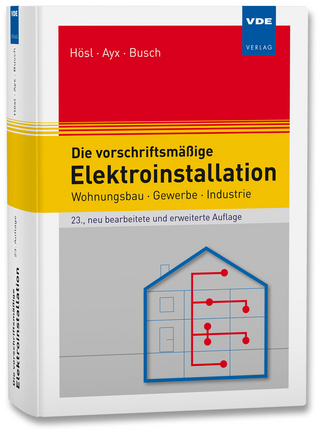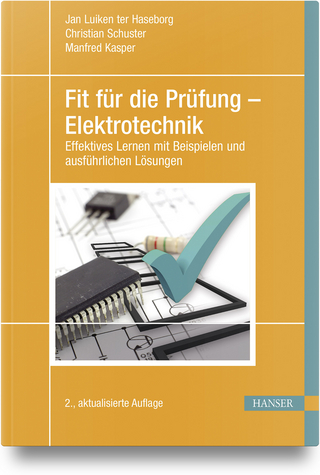Calculation of High-Frequency Current Distributions in Inverter-Fed Electrical Machines
Seiten
2013
|
1., Aufl.
Shaker (Verlag)
978-3-8440-1694-9 (ISBN)
Shaker (Verlag)
978-3-8440-1694-9 (ISBN)
- Titel ist leider vergriffen;
keine Neuauflage - Artikel merken
The thesis deals with the numerical calculation of the high-frequency parasitic currents in inverter-fed electrical machines. New methods and solutions are proposed to reduce the high-frequency parasitic currents by simple motor modifications.
Transmission line and frequency-response models of the AC machines can be used to calculate the high-frequency common mode stator ground currents. In the thesis, these models are investigated and their parameters are measured and calculated by analytical and numerical finite element methods (FEM). Further, an original high-frequency model of the AC machines, with an adequate representation of the stator winding and iron core for both the frequency and time-domain simulations, is proposed. The model is tested for several drive configurations and the results are verified by laboratory measurements.
The common mode current generates a circumferential magnetic flux in the stator laminated iron core, which induces a shaft voltage that may surpass the insulating properties of the bearing lubricant film and cause high-frequency circulating bearing currents in a loop formed by the stator, the rotor and the machine bearings. Assuming the rotational symmetry and the uniform radial current distribution in the lamination sheets, a 2D FEM common mode impedance model has been proposed in the literature to calculate the common mode currents and the induced shaft voltages. As an alternative to the existent 2D FEM models, in this thesis a 3D FEM model of the iron core impedance is proposed. The 3D FEM model considers better the radial distribution of the common mode current in the stator lamination sheets.
Using the common mode current as a current source, an equivalent transformer model has been previously proposed to calculate the circulating bearing currents. This model is improved here by considering the rotor impedance on the circulating bearing current path.
The voltage source inverters with high dv/dt at the machine terminals cause voltages on the machine bearings via the high-frequency machine capacitances. Once these voltages exceed the breakdown voltage of the lubricant, they discharge through the bearings, causing the electric discharge machining (EDM) currents. The proper calculation of the EDM currents depends on the proper calculation of the bearing voltages, which therefore depends on the calculation of the machine and bearing capacitances. Here, analytical and 2D and 3D numerical methods are used to calculate the machine and bearing capacitances. The results are verified by measurements. A method to calculate the bearing voltage directly from the common mode voltage has been previously proposed in the literature. In this thesis, an accurate calculation of the bearing voltage from the integral of the common mode current is proposed.
To precisely calculate the overvoltages and the common mode ground stator currents in the variable speed drives, the high-frequency models of the machines and cables have to be connected together. In this thesis, transmission line models of cables with constant parameters and frequency-dependent parameters are investigated and their advantages and disadvantages are discussed. The analytical and numerical calculation of the cable parameters is presented, and the results are compared to measurements.
Transmission line and frequency-response models of the AC machines can be used to calculate the high-frequency common mode stator ground currents. In the thesis, these models are investigated and their parameters are measured and calculated by analytical and numerical finite element methods (FEM). Further, an original high-frequency model of the AC machines, with an adequate representation of the stator winding and iron core for both the frequency and time-domain simulations, is proposed. The model is tested for several drive configurations and the results are verified by laboratory measurements.
The common mode current generates a circumferential magnetic flux in the stator laminated iron core, which induces a shaft voltage that may surpass the insulating properties of the bearing lubricant film and cause high-frequency circulating bearing currents in a loop formed by the stator, the rotor and the machine bearings. Assuming the rotational symmetry and the uniform radial current distribution in the lamination sheets, a 2D FEM common mode impedance model has been proposed in the literature to calculate the common mode currents and the induced shaft voltages. As an alternative to the existent 2D FEM models, in this thesis a 3D FEM model of the iron core impedance is proposed. The 3D FEM model considers better the radial distribution of the common mode current in the stator lamination sheets.
Using the common mode current as a current source, an equivalent transformer model has been previously proposed to calculate the circulating bearing currents. This model is improved here by considering the rotor impedance on the circulating bearing current path.
The voltage source inverters with high dv/dt at the machine terminals cause voltages on the machine bearings via the high-frequency machine capacitances. Once these voltages exceed the breakdown voltage of the lubricant, they discharge through the bearings, causing the electric discharge machining (EDM) currents. The proper calculation of the EDM currents depends on the proper calculation of the bearing voltages, which therefore depends on the calculation of the machine and bearing capacitances. Here, analytical and 2D and 3D numerical methods are used to calculate the machine and bearing capacitances. The results are verified by measurements. A method to calculate the bearing voltage directly from the common mode voltage has been previously proposed in the literature. In this thesis, an accurate calculation of the bearing voltage from the integral of the common mode current is proposed.
To precisely calculate the overvoltages and the common mode ground stator currents in the variable speed drives, the high-frequency models of the machines and cables have to be connected together. In this thesis, transmission line models of cables with constant parameters and frequency-dependent parameters are investigated and their advantages and disadvantages are discussed. The analytical and numerical calculation of the cable parameters is presented, and the results are compared to measurements.
| Reihe/Serie | Berichte aus der Elektrotechnik |
|---|---|
| Sprache | englisch |
| Maße | 148 x 210 mm |
| Gewicht | 321 g |
| Einbandart | Paperback |
| Themenwelt | Technik ► Elektrotechnik / Energietechnik |
| Schlagworte | Drehstrommaschine • Eisenker • Erdstrom • Gleichtaktstrom • Hochfrequenz • Lagerstrom • Parasitäres Element (Mikroelektronik) • Ständerwicklung • Stromrichtergespeiste Asynchronmaschine • Stromverteilung |
| ISBN-10 | 3-8440-1694-5 / 3844016945 |
| ISBN-13 | 978-3-8440-1694-9 / 9783844016949 |
| Zustand | Neuware |
| Haben Sie eine Frage zum Produkt? |
Mehr entdecken
aus dem Bereich
aus dem Bereich
Wegweiser für Elektrofachkräfte
Buch | Hardcover (2024)
VDE VERLAG
CHF 67,20




